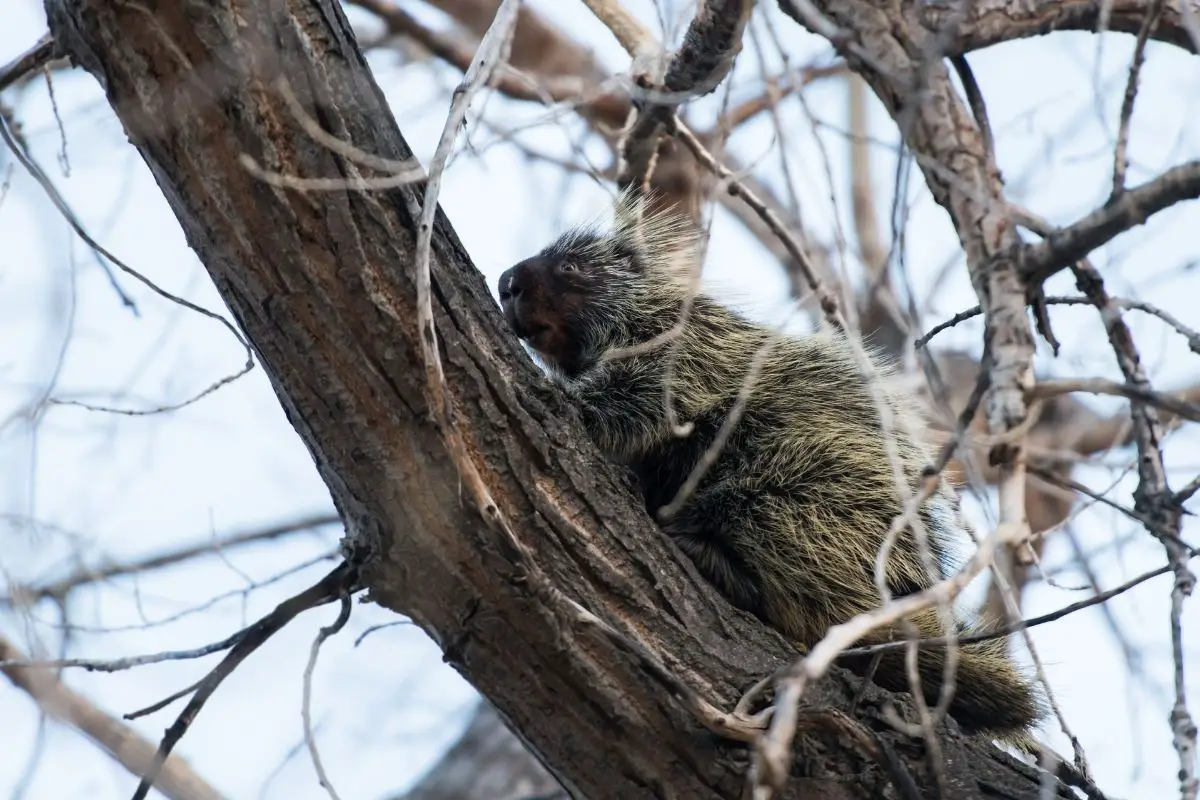
Depending on where you stand, there’s something about nature that’s cute, stubborn, destructive, or dangerous. When it comes to porcupines, they embody nature. Their adorable faces and non-aggressive demeanor are welcoming, but the 30,000 quills on a porcupine’s back say, “not too close.”
Quills are the thorn-like structures on a porcupine’s body. Sometimes, they’re referred to as spines. With a porcupine, it’s a matter of ‘just look and don’t touch.’
Trust me, I learned this the hard way once I developed an interest in these animals! On the positive side, I also discovered that, contrary to popular belief, porcupines don’t shoot their quills. What happens is they get stuck and dislodge once they come into contact with human or animal flesh.
This is made possible by microscopic fish-hook-like barbs at the tip of each quill. But there is much more to this cute, ‘look but don’t touch,’ mammal. Let’s explore.
Amazing Facts About Porcupines
Porcupines are the world’s third-largest rodent after the capybara and the beaver. The quill-covered animals use their quills to defend against predators like lions, leopards, and humans. Biologically, porcupines are in the order Rodentia, but they subdivide into the Hystricidae and Erethizontidae families.
In layman’s terms, these two families are understood as Old World porcupines and New World porcupines, respectively. Old World porcupines are found in Asia, Italy, and Africa, while the New World porcupines are in North America and northern South America. Furthermore, porcupines are nocturnal, but the New World porcupines are not strictly nocturnal.
At times they come out during the day. They can also inhabit the trees and are generally smaller in size.
Different Types of Porcupines That Exist Today
There are many types of porcupines, many being considered new world and the others old world porcupines. Some of the new world porcupines are from a declassification of defunct taxonomic groups. Follow along as we explore all the types including their histories, habitats, diets, size, and much more..
Old World Porcupines
Old World porcupines are terrestrial rodents. They are larger and are strictly nocturnal. They primarily live in Africa, Europe, and Asia.
1. African Brush-tailed Porcupine
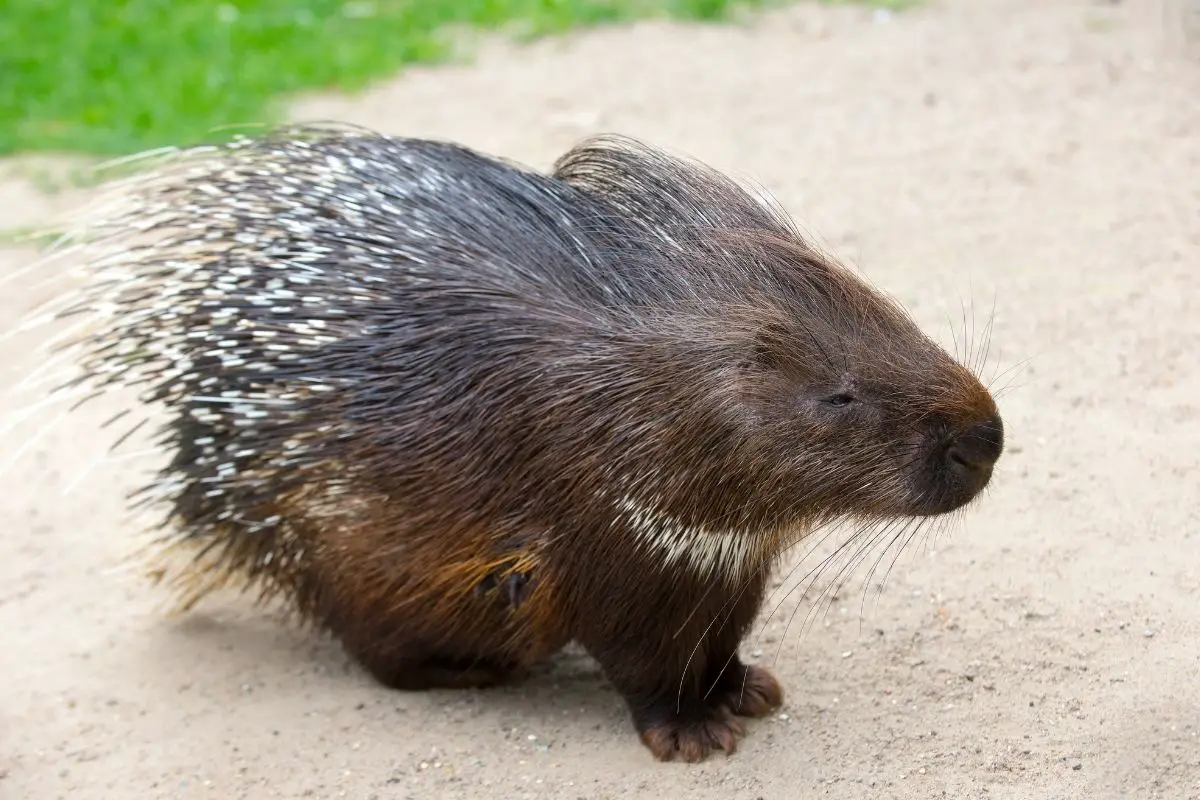
The African brush-tailed porcupine is a small rat-like porcupine. This type is usually found in Africa, in the area spanning Guinea to Kenya. Humans hunt it for meat.
According to the classification by the International Union for Conservation of Nature, it is of least concern despite the threat of hunting.
- Length without tail: 15.7 -19.6 inches
- Weight: 6.6 pounds
- Distribution: Africa
- Habitat: forest, rainforest, caves, and subterranean habitats
- Diet: Herbivores (leaves, flowers, fruits, palm nuts, maize, cassava, bananas), carrion
- Sleep behavior: Nocturnal
- Gestation period: 106
- Sexual maturity: 2 years
2. Asiatic Brush-tailed Porcupine (Atherurus macrourus)
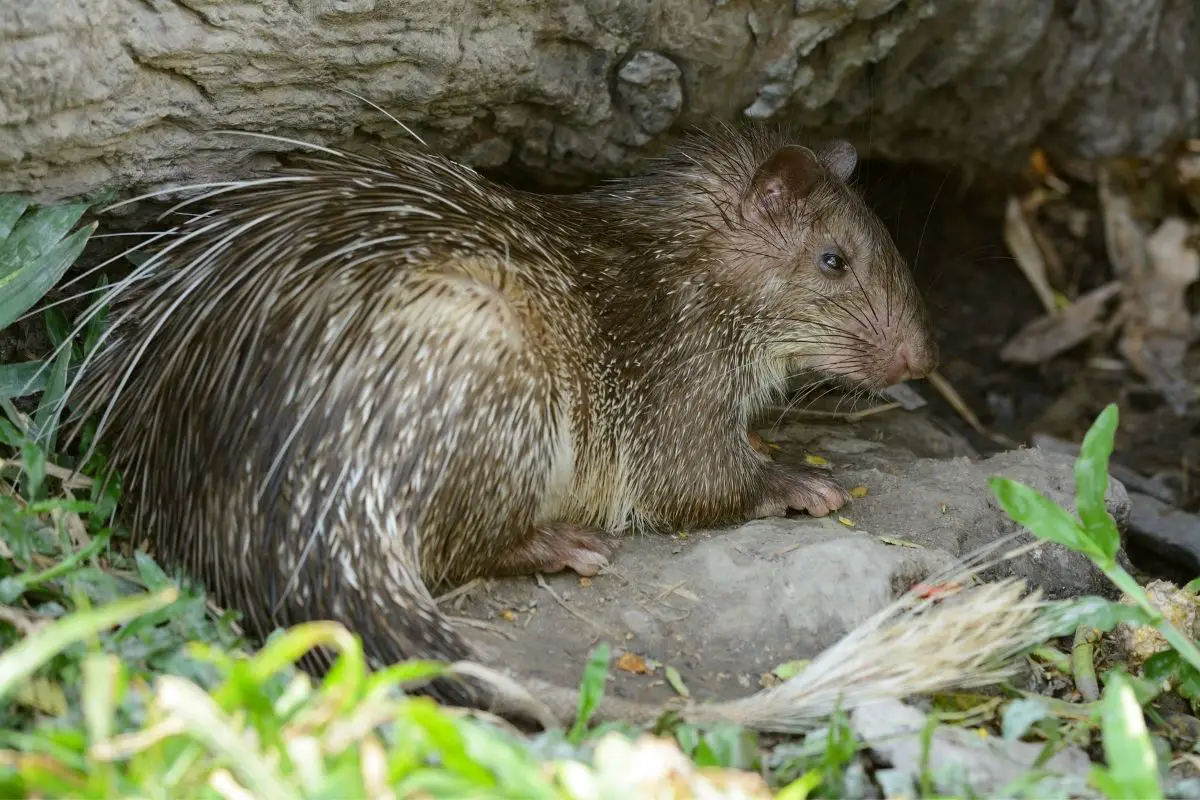
The Asiatic brush-tailed porcupine is one of the rarest porcupines in South Asia; hence, it is a protected species in India and other regions in South Asia. These porcupines hunt at night and forage at dawn and dusk. They are primarily nocturnal and construct their habitat by burrowing in a space under the earth to accommodate up to three Asiatic brush-tailed porcupines.
- Length without tail: 14.5 -23.6 inches
- Weight: 2.2 – 9.5 pounds
- Distribution: Asia
- Habitat: Subtropical and tropical montane forests
- Diet: Herbivores
- Sleep behavior: Nocturnal
- Gestation period: 100 days
3. African Crested Porcupine (Hystrix cristata)
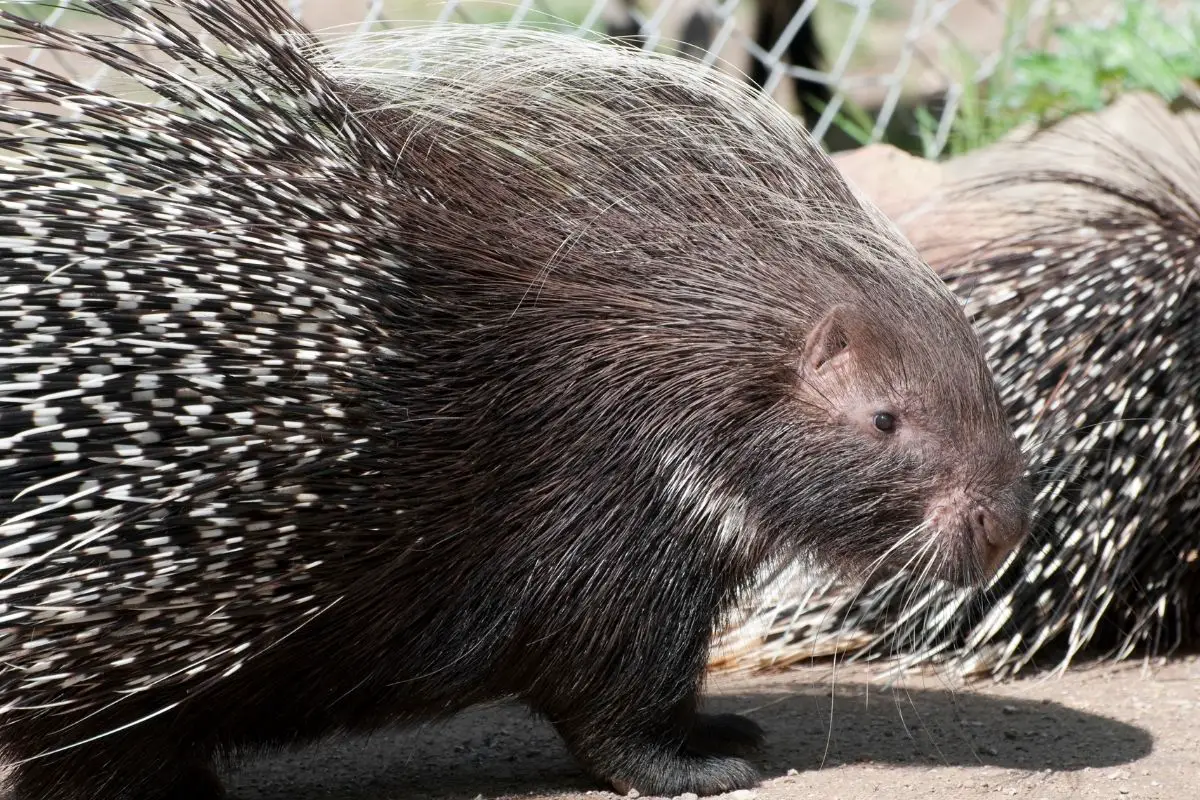
The crested porcupine is one of the largest rodents on earth. The crested porcupine is also known as the African Crested porcupine. When under threat, they raise whir quills to look much bigger.
If the danger persists, they stamp their feet, whirr their quills and charge toward their attacker and try to stab them with the quills. Their attack can be fatal. It has killed lions, leopards, hyenas, and humans. Surprisingly, the crested porcupines might appear clumsy on land, but they are agile swimmers.
Even being good at swimming, they do not migrate with the seasons.
- Length without tail: 24 -33 inches
- Longest quill: 14 inches
- Weight: 29 – 60 pounds
- Age: 15 -20 years
- Distribution: Africa, Europe
- Habitat: Forest, mountains, grassland, rocky area, savanna, shrubland
- Diet: Herbivores (cultivated crops, fruits, bulbs, tubers, rhizomes, roots, barks), small insects, small vertebrates.
- Sleep behavior: Nocturnal
- Relationship: Monogamous
- Gestation period: 112 days
- Sexual maturity: 1 -2 years
4. Cape Porcupine (Hystrix africaeaustralis)
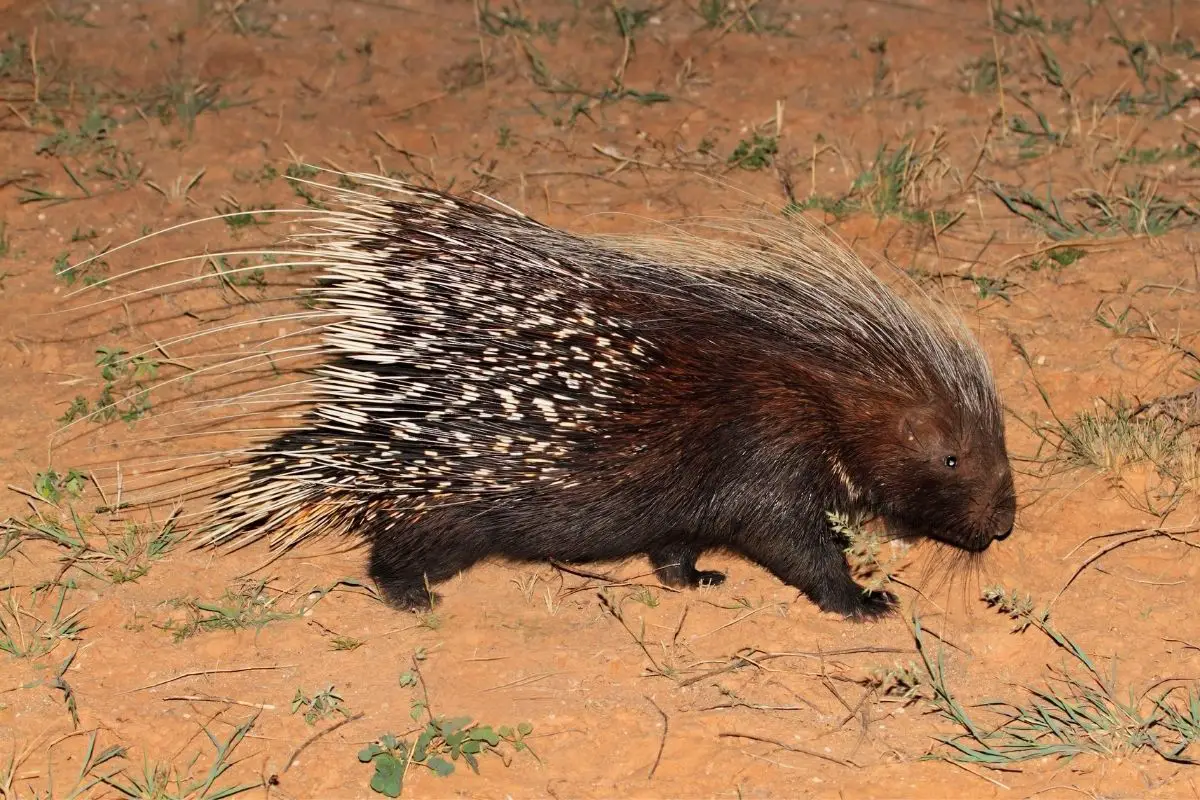
The Cape porcupine is also referred to as the South African porcupine. It is mainly found in the South and Central African region between 0 to 2000 feet above sea level. This porcupine is the largest rodent in Africa and the largest porcupine globally.
Sometime, it can be confused with the crested porcupines, but the Cape has a white streak of quills around the neck.
- Length without tail: 32 inches
- Tail length: 8 inches
- Longest quill: 20 inches
- Attack quill length: 12 inches
- Weight: 66 pounds
- Age: 10 -20 years
- Distribution: Africa
- Habitat: Tropical savanna, shrubland, forest, grassland, savanna, desert
- Diet: Herbivores (fruits, roots, tubers, barks, bulbs)
- Sleep behavior: Nocturnal
- Relationship: Monogamous
- Gestation period: 94 days
- Sexual maturity: 1 year
5. Indian Crested Porcupine (Hystrix indica)
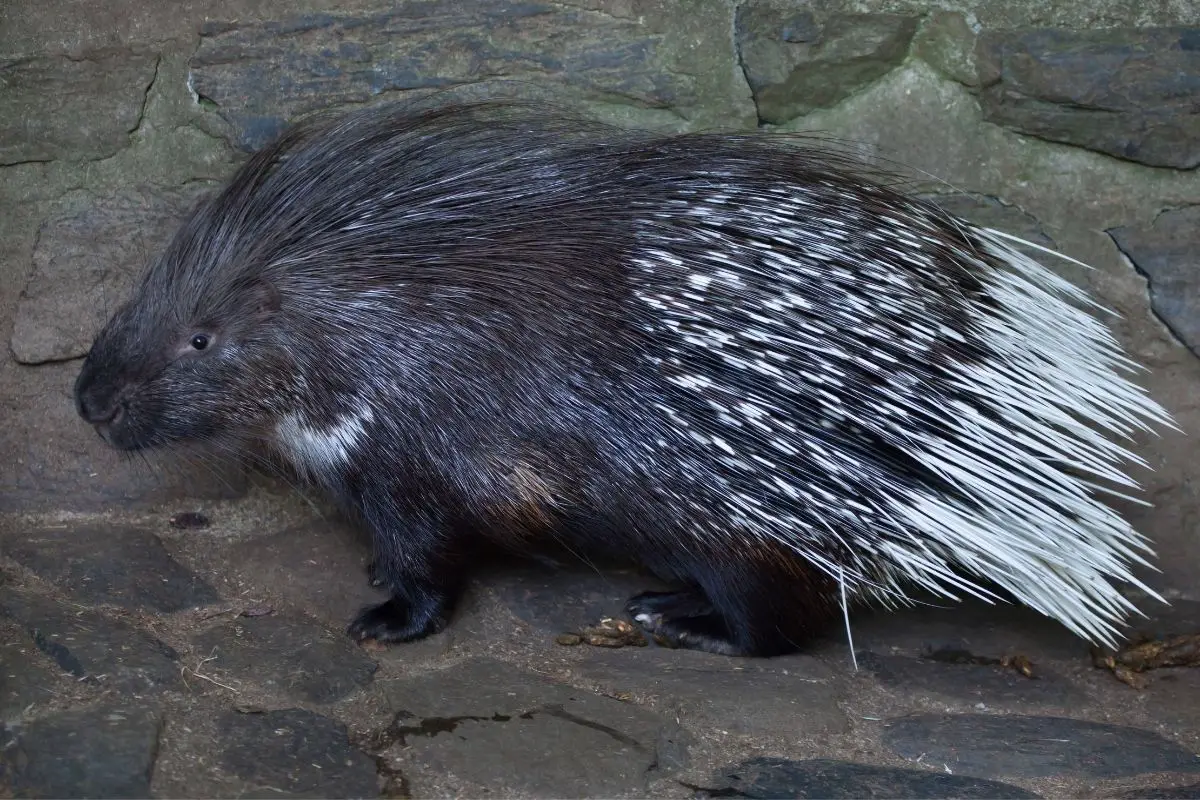
The quills of the Indian crested porcupine form a skirt around the neck. The longest quills are around the neck, and the short and sturdier ones are towards the back. These short and sturdy quills are for attacking a threat.
The quills at the tail are white with longer hollow quills that rattle as a warning to the threat. Furthermore, the porcupine has broad feet with claws for burrowing. Their small surface area to volume ratio also comes in handy in cold seasons.
- Length without tail: 28 -35 inches
- Tail length: 3 – 4 inches
- Longest quill: 20 inches
- Attack quill length: 8 inches
- Weight: 24 -40 pounds
- Age: 27 years
- Distribution: Southwest and Central Asia
- Habitat: Rocky hillside, tropical and temperate shrublands, grasslands, forests, plantations, and gardens.
- Diet: Herbivores (roots, bulbs, fruits, grain, drupe, tubers), small insects, small vertebrates.
- Sleep behavior: Nocturnal
- Relationship: Monogamous
- Gestation period: 240 days
- Sexual maturity: 2 years
6. Malayan Crested Porcupine (Hystrix brachyura)
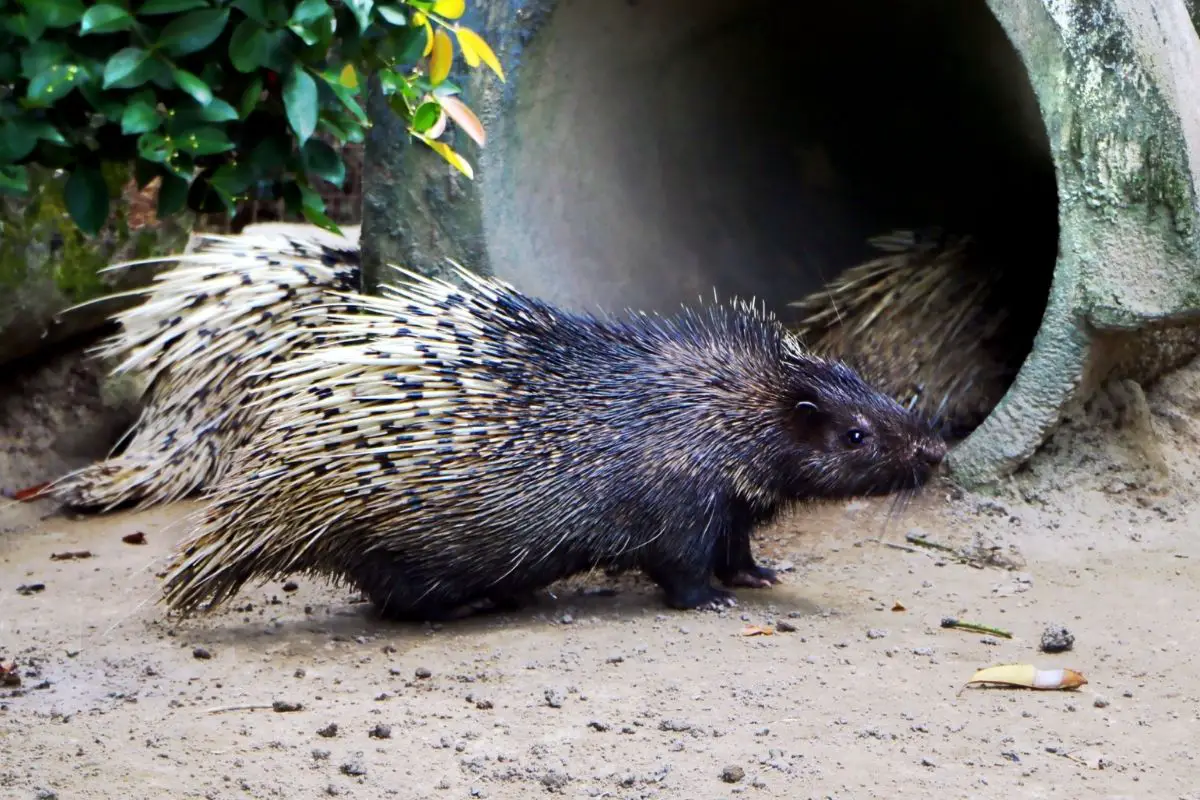
Also known as the Himalayan porcupine, this mammal is a large rodent with a stout body covered with sharp quills with a rigid structure. The quills on the upper body are rough and characterized by black, white, and yellow stripes.
In addition, the Malayan porcupine has short, stocky legs, with the front legs having four claws and the hind legs having five clays. The soles of the porcupine are smooth.
- Length without tail: 22 -29 inches
- Tail length: 2.3 – 4.3 inches
- Weight: 22 – 40 pounds
- Age: 27 years
- Distribution: Nepal, North East India, Bangladesh, Central, and Southern China
- Habitat: Rocky areas, holes in trees, root systems
- Diet: roots, tubers, barks, fallen fruits, insects, carrion, large tropical seeds.
- Sleep behavior: Nocturnal
- Relationship: Monogamous
- Gestation period: 90 – 112 days
7. Sunda Porcupine (Hystrix javanica)
The Sunda porcupine, scientifically referred to as Hystrix javanica, is a rodent species belonging to the Hystricidae family. It is only found in Indonesia. According to the Indonesian government, Sunda porcupines are a protected species.
Despite this protection, these porcupines still face danger because they’re hunted and consumed as an aphrodisiac.
- Length without tail: 18 -26 inches
- Tail length: 2.3 – 6.7 inches
- Weight: 17 – 60 pounds
- Distribution: Asia, Indonesia
- Habitat: Forest, shrubland
- Diet: Herbivores
- Sleep behavior: Nocturnal
8. Sumatran Porcupine (Hystrix sumatrae)
The Sumatran porcupine is an endemic species in Indonesia. They’re dark brown in color, but half of their quills and bristles are white-tipped, giving them a speckled, grey appearance. Sumatran porcupines have sharp flattened quills, stiff bristles, and rattle quills as body cover with more flexible quills and bristles on their cheeks, belly, and feet.
The quills and bristles can grow up to 16 cm long. Rattle quills are found on the tail and have hollow tips that produce a hissing rattle sound when they shake. However, these quills do not develop until the animal reaches maturity.
- Length without tail: 18 -22 inches
- Weight: 8.4 – 10 pounds
- Distribution: Asia, Indonesia
- Habitat: Forest, shrubland, rainforest, tropical zones
- Diet: Herbivores
- Sleep behavior: Nocturnal
9. Thick-spined Porcupine (Hystrix crassispinis)
The thick-spined porcupine was once a threatened species, but it is now of least concern since 2008. The adaptability of the porcupine helped curb its extinction despite being hunted for food. The thick-spined porcupine can also be called the Bornean rattle porcupine.
The porcupine resembles the large-small toothed beavers with long toes and pale quills. The porcupine’s fur is brown or grey and has a pale underbelly, neck, and inside of the legs.
What you need to know about the Thick-spines porcupine:
- Length without tail: 17 inches
- Quill length: 7 inches
- Weight: 3.3 – 6.6 pounds
- Distribution: Asia, Indonesia, Malaysia, Brunei
- Habitat: Natural forests, agricultural areas, should be 3,900 ft. above sea level
- Diet: Herbivores
- Sleep behavior: Nocturnal
- Reproduction: Viviparous
10. Philippine Porcupine (Hystrix pumila)
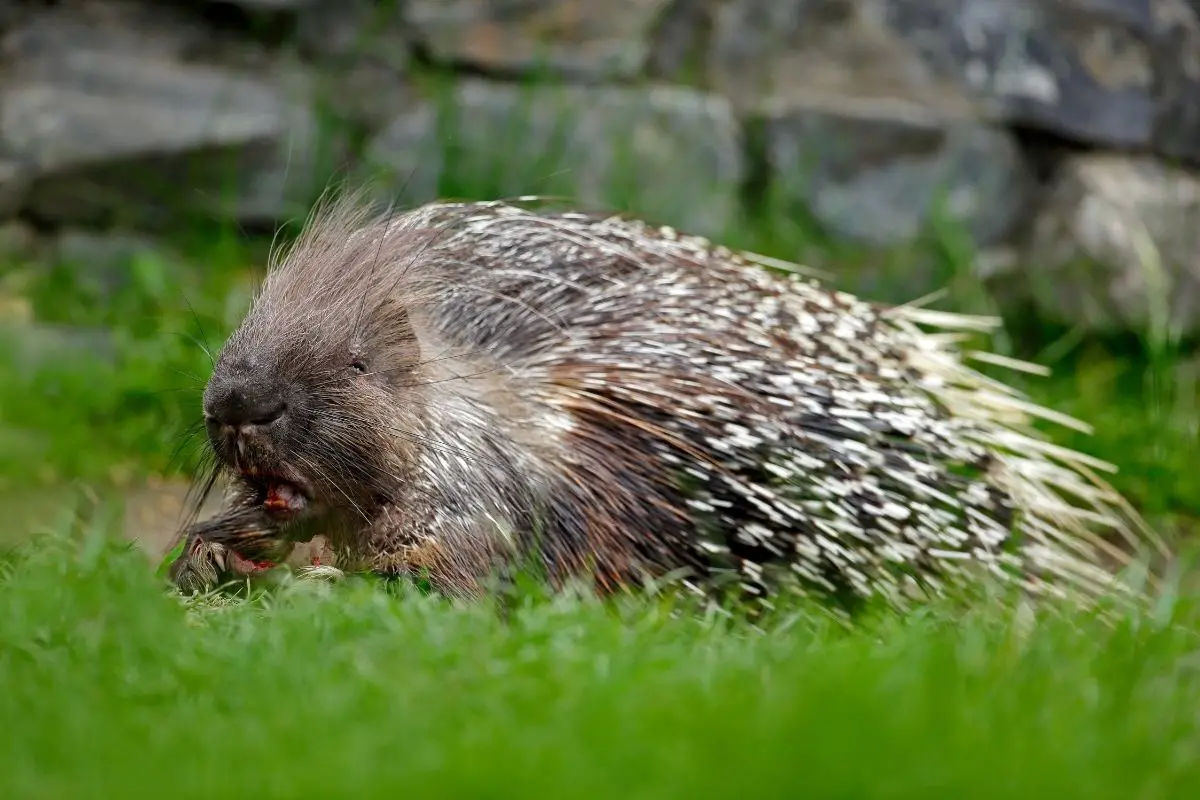
Locally known as durian or landak, the Philippine porcupine species is found in primary and secondary forests in the mountains and lowlands. Its population appears to be stable as it is reported to be persecuted by farmers as a pest in coconut plantations. This species can also be found in caves, but it is more commonly found under tree buttresses or in rock crevices.
It is endemic and only found in the Palawan Faunal Region. It has also been seen in areas such as the islands of Busuanga, Coron, and the Puerto Princesa Subterranean River National Park. This mammal does not appear to have any natural enemies.
It is considered a pest by the coconut farmers who hunt it.
- Length without tail: 1.38 – 3.05 ft.
- Tail length: 0.98 – 7.48 inches
- Weight: 8.4 – 11.9 pounds
- Distribution: Asia, Philippines
- Habitat: Forests, mountains, caves, agricultural fields, shrubland, rocky areas, urban wildlife
- Diet: Herbivores
- Sleep behavior: Nocturnal
- Reproduction: Viviparous
- Gestation period: 93 -105 days
11. Long-tailed Porcupine (Trichys fasciculata)
The long-tailed porcupine is the lightest among old-world porcupines and the smallest family member. They are rat-like and have the longest tail among old-world porcupines. Southeast Asia is their home – Sumatra to the west and south, and Borneo to the east and south.
The Malay peninsula forms the northern boundary of their distribution. Areas such as rain forests, peat swamp forests, lowland rain forests, freshwater swamp forests, rain forests, mountain rain forests, and heath forests are their natural habitats in subtropical and tropical regions.
- Length without tail: 11 – 19 inches
- Tail length: 11.8 inches
- Weight: 3.3 – 5.1 pounds
- Distribution: Asia, Brunei, Indonesia, Malaysia
- Habitat: Rainforest, forest, grassland, swamp, wetlands
- Diet: Herbivores
- Sleep behavior: Nocturnal
- Reproduction: Viviparous
- Gestation period: 7 months
New World Porcupines (family Erethizontidae)
New world porcupines, like the old world porcupines, are rodents covered in fur and quills. The new world porcupines mainly inhabit North America and Northern South America. However, these porcupines do not only vary from the old world porcupines geographically, but they vary in many other things.
The new world porcupines have rooted molars, a fully developed upper lip, and complete collar bones. In addition, they do not have first front toes, their soles are tuberculate, and they have four teats. Furthermore, new world porcupines are stout with mobile snouts.
Their coat either has cylindrical or flattened quills mixed with long hairs. Their heads are rounded and fleshy. Unlike the old world porcupines, they are not exclusively nocturnal or terrestrial. They can feed during the day, and some species live entirely on trees.
Mostly, they diet on barks and leaves but can also eat roots, fruits, nuts, leaves, grass, flowers or even stems. In addition, some species feed on insects and small vertebrates.
Examples of the new world porcupines include:
- Erethizon genus, e.g., North American Porcupine (Erethizon dorsatum)
- Coendou genus eg C. prehensilis, C. ichillus, C. roosmalenorum, C. melanurus, C. sneiderni, C. roosmalenorum, C. rothschildi etc.
- Echinoprocta genus eg. E. rufescens
- Sphiggurus genus, e.g., S. insidiosus, S. vestitus, S. villosus, etc
12. Brazilian Porcupine (Coendou prehensilis)
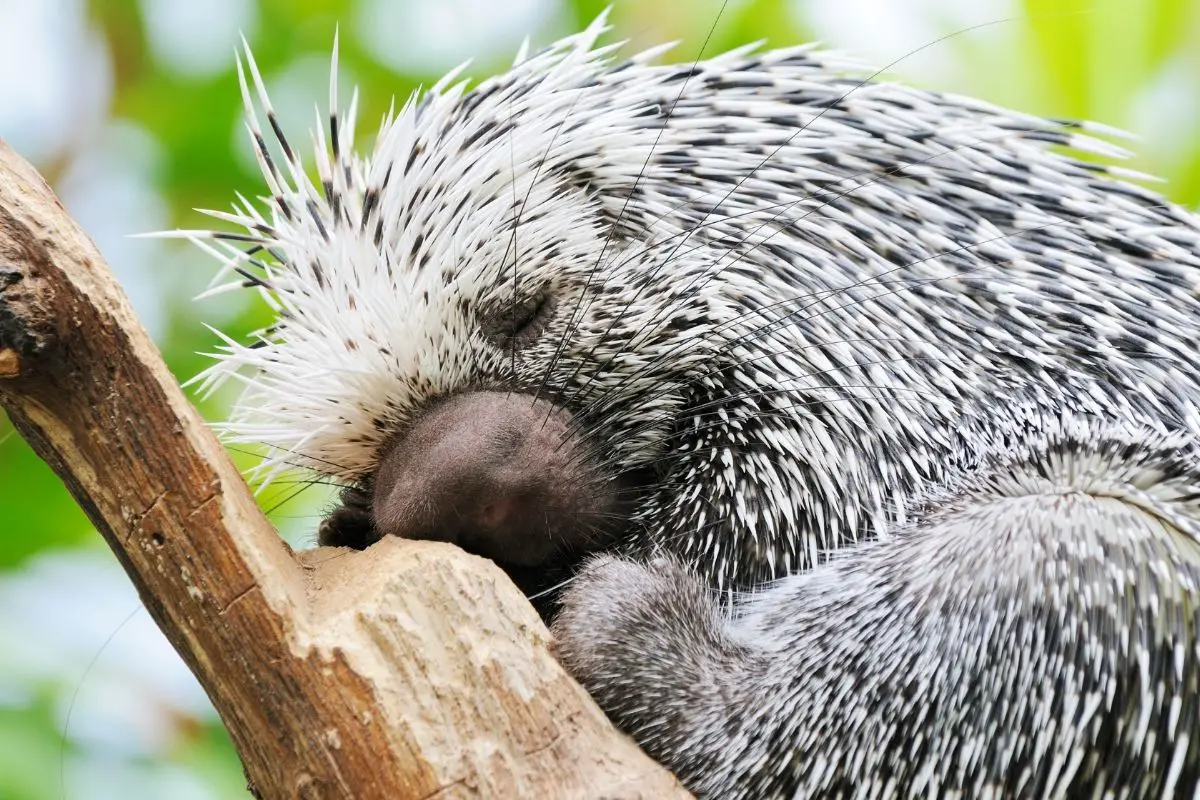
The Brazilian porcupine is covered with short thick quills which can be whitish or yellowish. The quills mix with darker hair, but the hair on the underside is greyish. These porcupines have a fleshy nose and a long tail that curls at the tip to aid grip while climbing trees.
What you should know about the Brazilian porcupine:
- Length without tail: 1 -2 ft.
- Tail length: 13 – 19 inches
- Weight: 4 – 11 pounds
- Age: 17 years
- Distribution: Northern South America
- Habitat: Forests and grassland
- Diet: Leaves, barks, fruit, flower
- Sleep behavior: Nocturnal
- Relationship: Monogamous
- Gestation period: 7 months
13. Bicolored-spined Porcupine (Coendou bicolor)
The quills of the bicolored-spined porcupine are pale yellow at the base and a black tip. The spines are dense on the back of the porcupine but none on the tail. The tail is for grip while climbing trees.
What you should know about the Indian porcupine:
- Length without tail: 21 inches
- Tail length: 19 inches
- Weight: 10 pounds
- Distribution: South America, Argentina, Bolivia, Brazil, Peru
- Habitat: Forests
- Diet: Herbivores (roots, bulbs, fruits, grain, drupe, tubers), small insects, small vertebrates.
- Sleep behavior: Nocturnal
- Relationship: Monogamous
14. Andean Porcupine (Coendou quichua)
The Andean porcupine is a rare type of porcupine, and its population is decreasing due to habitat fragmentation, deforestation, and agriculture. This porcupine has a large, pink nose with small eyes. Its body is covered in spiky dark quills with a yellowish tip.
It also has a tail that starts broad but slims towards the end to aid in holding onto branches while climbing trees.
- Length without tail: 13 -17 inches
- Tail length: 11 – 16 inches
- Weight: 4 pounds
- Distribution: South America, North America, Panama, Ecuador, Colombia
- Habitat: Forest
- Diet: Herbivores (fruit and leaves)
- Sleep behavior: Nocturnal
- Relationship: Monogamous
15. The Black Dwarf Porcupine (Coendou nycthemera)
The Black dwarf porcupine is also known as Koopman’s porcupine. The porcupine is endemic in northern Brazil, specifically in the Amazon rainforest. Primarily it inhabits the primary forest but can also inhabit second growth.
- Distribution: Brazil
- Habitat: Forest, Rainforest
- Diet: Herbivores
- Sleep behavior: Nocturnal
16. Santa Marta Porcupine (Coendou sanctamartae)
The Santa Marta porcupine is mostly found in dry forests at altitudes below 1100 meters. These porcupines are small in size and have a black and white appearance due to their quills which are black at the base and white towards the tip. This type is found in dry forests on the lower slopes of Colombia’s Sierra Nevada de Santa Marta, as well as the Serrana del Perijá mountains and the surrounding areas.
Some scientists refer to it as a subspecies of the Brazilian porcupine.
- Distribution: South America. North America
- Habitat: Forest, Mountains
- Diet: Herbivores Sleep behavior: Nocturnal
17. Mexican Hairy Dwarf Porcupine (Coendou mexicanus)
The Mexican hairy dwarf porcupine has a dark appearance with yellow decoration from the yellowish quills that the porcupine has. Mostly the quills are visible on the front of the porcupine because it has a hairless head – the yellowish quills are not disguised. This porcupine’s broad, bulbous snot is pink in color, and the tail is prehensile (capable of grasping).
- Length without tail: 12.6 – 18 inches
- Tail length: 8 -14 inches
- Weight: 6 pounds
- Distribution: North America
- Habitat: Forest
- Diet: Herbivores (buds, young leaves, seeds, and fruits)
- Sleep behavior: Nocturnal
18. Paraguaian Hairy Dwarf Porcupine (Coendou spinosus)
This porcupine is mostly found in South America and has a short, prehensile tail. Its quills are gray-brown, with the brown emerging from the colorful quills that run along its spine.
- Distribution: South America
- Habitat: Forest, Savanna
- Diet: fruits, roots, vegetables, and pupae
- Sleep behavior: Nocturnal
19. Bahia Porcupine (Coendou insidiosus)
Bahia porcupine is a porcupine species that is endemic to the Atlantic forest in Brazil. They are solitary(live alone) and eat both day and night (nocturnal). The Bahia porcupine is also omnivorous (consumes both plants and animals).
They also have parental care, where the females provide the care.
- Length with tail: 24 -32 inches
- Weight: 2.64 – 3.30 pounds
- Age: 15 years
- Distribution: Brazil
- Habitat: Forest, Savanna, Grassland.
- Diet: Herbivores (wood, bark, stems, seeds, grains, nuts, fruit, flower, leaves, roots, and tubers), small insects, and small vertebrates.
- Sleep behavior: Nocturnal
- Gestation period: 200 days
- Sexual maturity: 1.5 -2.5 years
20. Brown Hairy Dwarf Porcupine (Coendou vestitus)
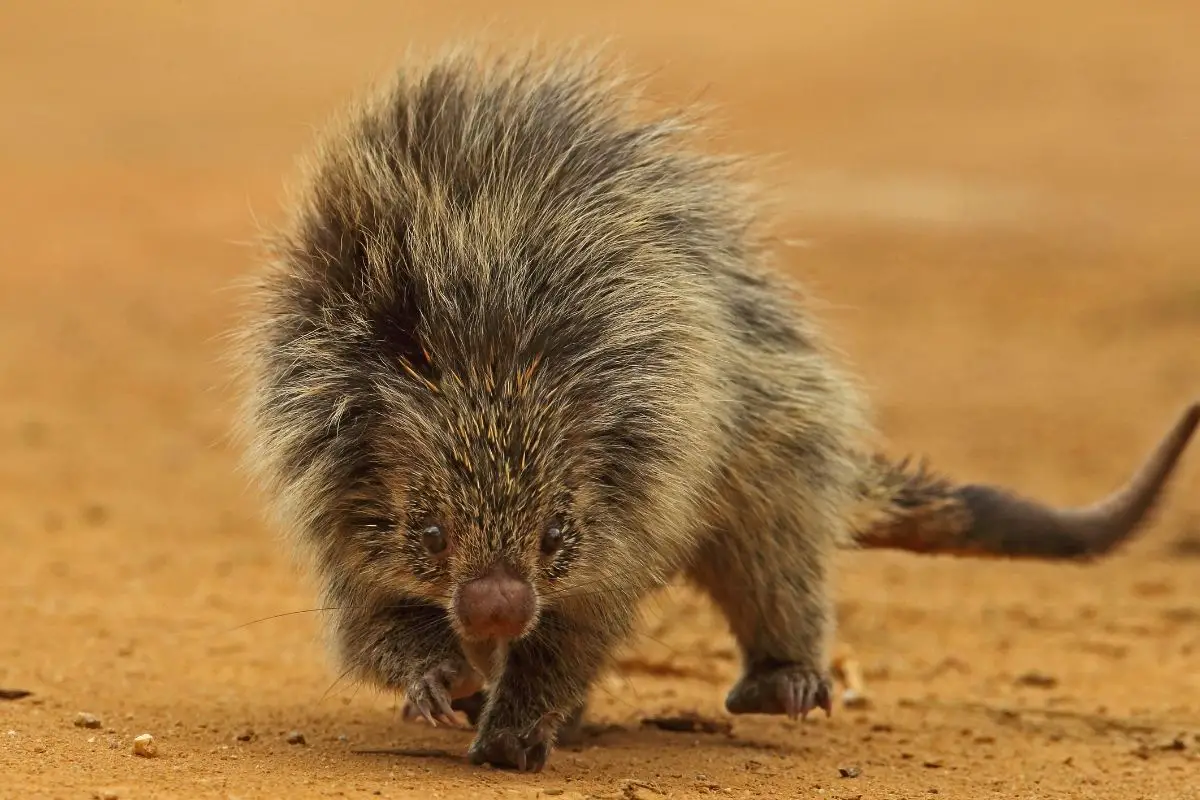
The brown hairy dwarf porcupine is a small to medium-sized porcupine with a prehensile tail that aids its mobility on trees. It is covered with long brown hair and hardened yellowish quills.
Below is what you need to know about the brown hairy dwarf porcupine
- Length without tail: 22 – 31.5 inches
- Weight: 3.30 – 5.51 pounds
- Age:15 years
- Distribution: Central Mexico
- Habitat: forest, rainforest, mountains, scrub forest
- Diet: Herbivores (leaves, fruit)
- Sleep behavior: Nocturnal
21. Streaked Dwarf Porcupine (Coendou ichillus)
The streaked dwarf porcupine is a small porcupine with barbed quills that are bicolored and no barbed quills that are thinner and longer than the barbed. Quills. The porcupine attacks with barbed quills. The reference streaked is because its quills have a white tip and base and a dark middle, and they run throughout the body except on the underside.
The tricolored quills give it the streaked appearance.
- Weight: 1.3 pounds
- Distribution: Ecuador
- Habitat: Amazonian lowlands
- Diet: Herbivores
- Sleep behavior: Nocturnal
22. Black-Tailed Hairy Dwarf Porcupine (Coendou melanurus)
This type is a new world porcupine found in South America. It was formerly believed that this species belonged to the genus Sphiggurus. However, this is no longer the case considering genomic studies showing that it is polyphyletic (has more than one ancestry). This species is closely related to Coendou vestitus(brown hairy dwarf porcupine), frosted hairy dwarf porcupine (Coendou pruinosus), and the streaked dwarf porcupine (Coendou ichillus).
- Distribution: South America
- Habitat: Forest
- Diet: Herbivores
- Sleep behavior: Nocturnal
23. Roosmalen’s Dwarf Porcupine (Coendou roosmalenorum)
The Roosmalen’s dwarf porcupine is covered with brownish or grayish fur and has bicolored quills and tricolored bristle quills. The name comes from the people who discovered it – Marc van Roosmalen and his son Tomas. The first specimen of this porcupine species was collected from the middle Madeira River.
- Length without tail: 11.4
- Tail length: 9.7 inches
- Weight: 24 -40 pounds
- Age: 27 years
- Distribution: Rio Madeira
- Habitat: Amazon forest
- Diet: Herbivores
24. Frosted Hairy Dwarf Porcupine (Coendou pruinosus)
The frosted hairy dwarf porcupine is from Colombia and Venezuela’s northern and eastern parts. The porcupine lives in the lowland at elevations of above 160 ft. but below 8530 ft. Genealogical investigations have shown that unlike the previous genus assignment, this porcupine is polyphyletic, meaning it has more than one ancestry.
It was previously referred to Sphiggurus, which is no longer recognized as a genus distinct from Coendou.
- Distribution: Colombia, Venezuela
- Habitat: tropical rainforest, cloud forest
- Diet: Herbivores
25. Stump-tailed Porcupine (Coendou rufescens)
The stump-tailed porcupine gets its name from its shorter tail than the other typical porcupines in a similar classification. It is still prehensile despite a short tail because it uses its tail to climb trees. However, the tail has evolved instead of wrapping around the tree.
Instead, it only hangs on the branch like a coat hanger.
- Distribution: Colombia, Ecuador, Northern Peru
- Habitat: Forest
26. Northern American Porcupine (Erethizon dorsatum)
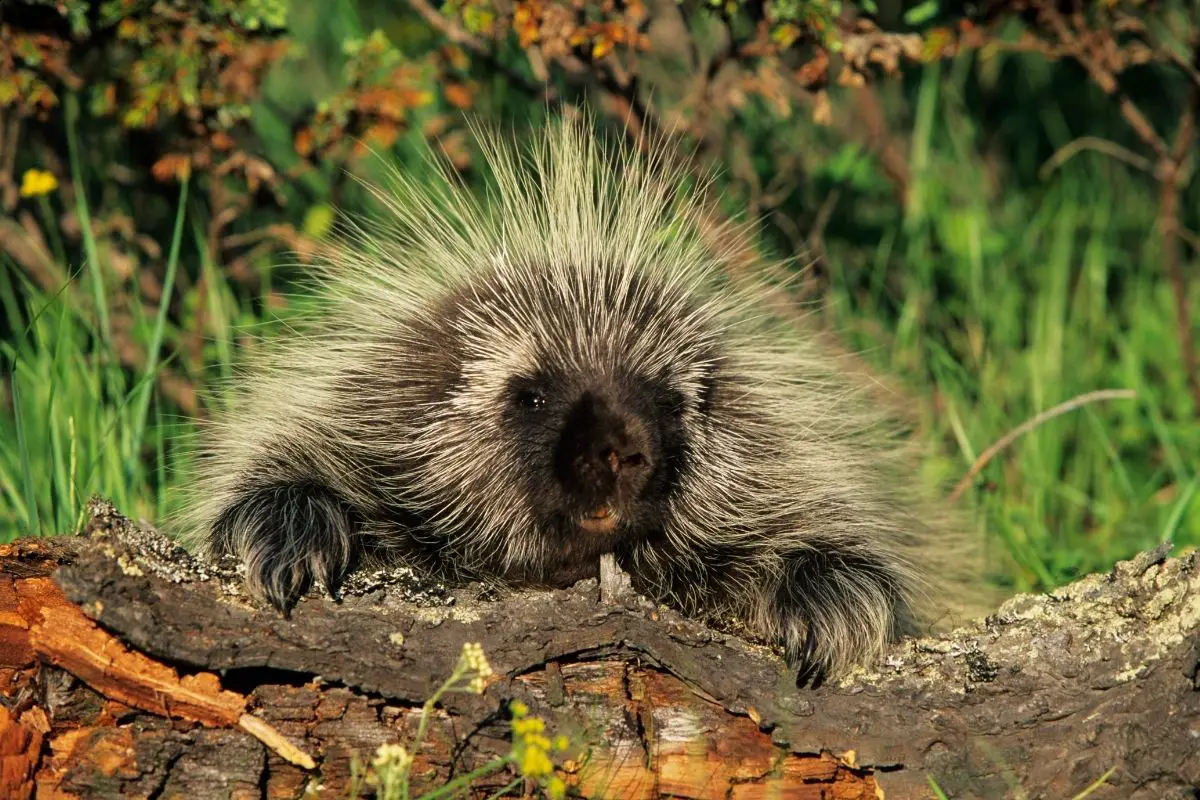
This porcupine is also known as the Canadian porcupine. The northern American porcupine is fully covered in quills, and an adult can have up to 30,000 quills covering them all over except the underbelly, the feet, and the face. They also have a natural antibiotic to heal it if it falls from a tree and injures itself with its quills.
This type is usually black or dark brown but has white highlights.
- Length without tail: 2 -3 ft.
- Tail length: 5.7 – 11.8 inches
- Weight: 15 pounds
- Age: 30 years
- Distribution: North America
- Habitat: Rocky areas, grasslands, forests, Tundra, Taiga, shrubland
- Diet: Herbivores (tree bark, conifer needles, berries, stem, roots, twigs) small
- Sleep behavior: Nocturnal
- Gestation period: 202 days
27. Bristle-spined Porcupine (Chaetomys subspinosus)
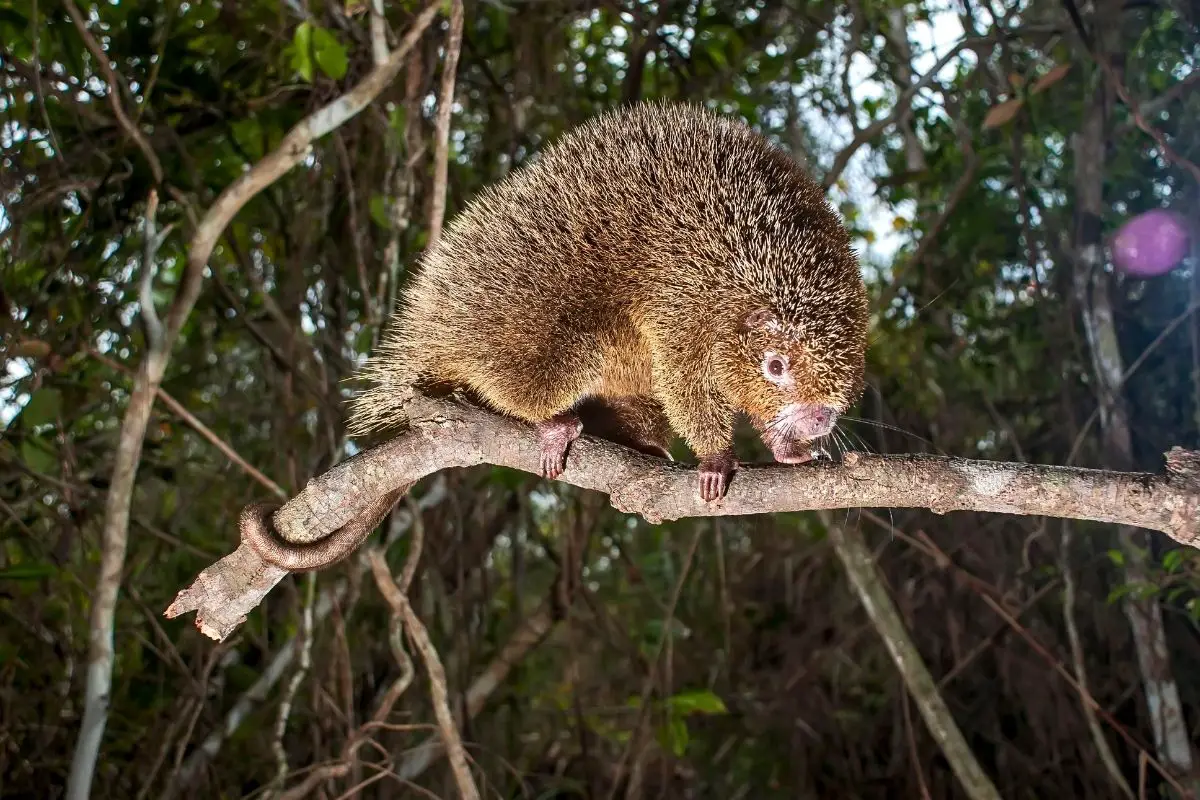
The bristle-spined porcupine crosses several taxonomic classifications, hence its other name, bristle-spined rat. Its bristles are softer than regular porcupine quills, but the head shape resembles the new world porcupines, especially the eye socket. For such reasons, the porcupine crosses several taxonomic classifications, including others that do not qualify as porcupines.
- Length without tail: 15 -18 inches
- Weight: 2.9 pounds
- Distribution: Brazil
- Habitat: forest
- Diet: Herbivores
- Sleep behavior: Nocturnal
- Relationship: Monogamous
- Gestation period: 240 days
- Sexual maturity: 2 years
Now you know all there’s to know about porcupine populations across the globe. Note that it is impossible to estimate the global porcupine population due to the difficulty of conducting demographic studies. Fisher predation and human development are the only known dangers to population expansion at this time.
